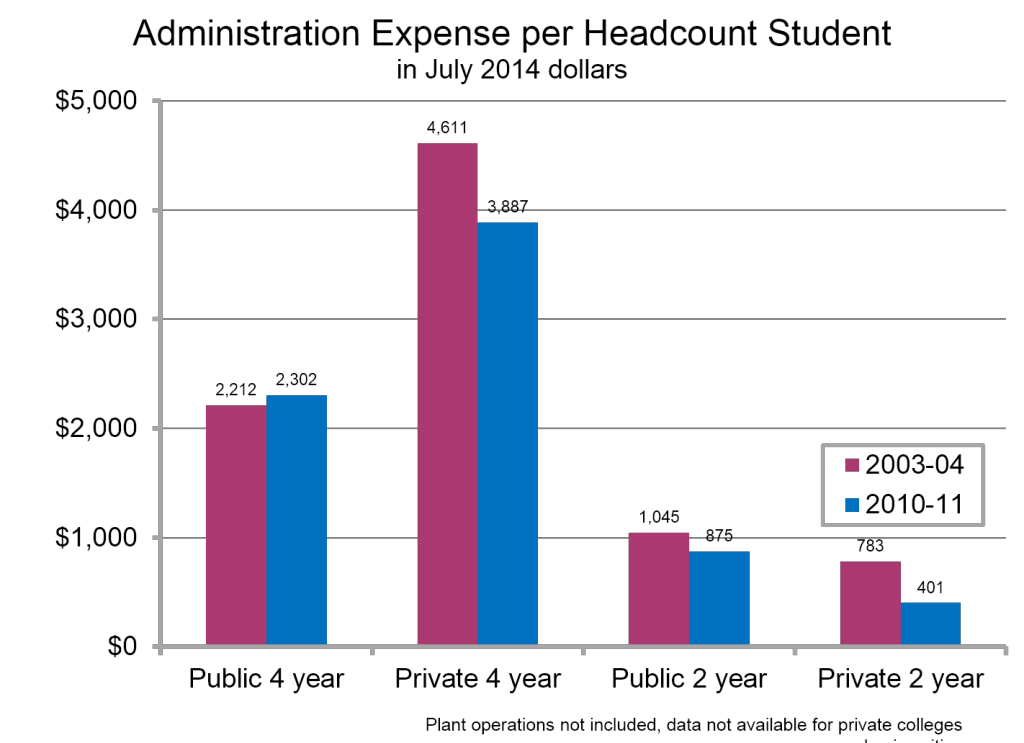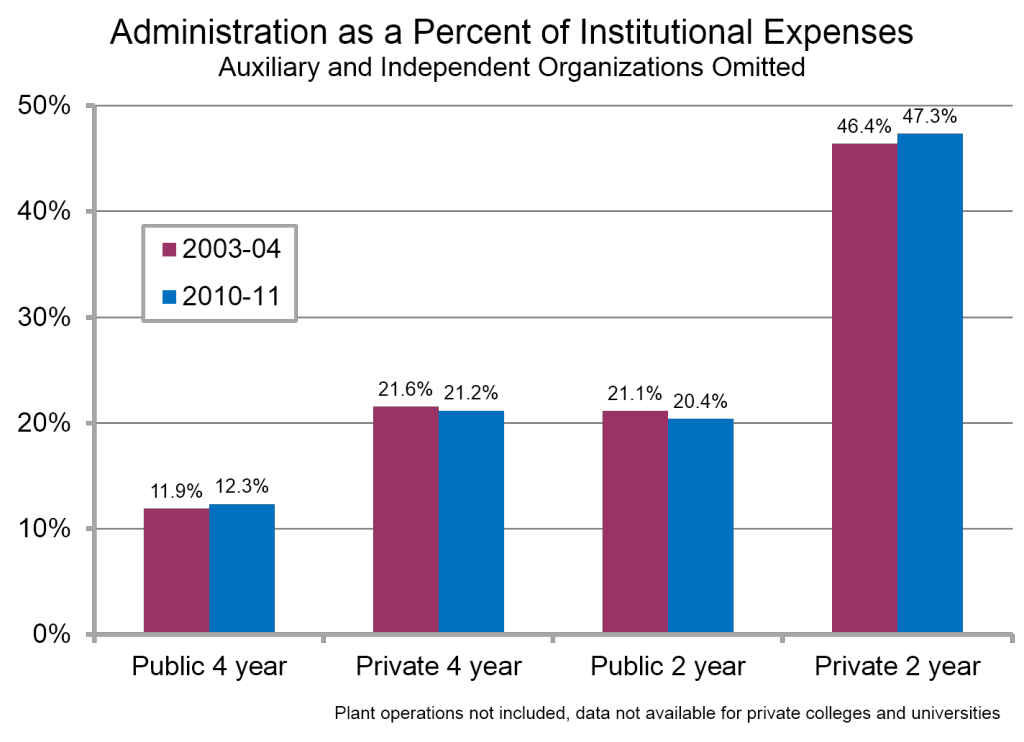August 27, 2014
There’s just a mind-boggling amount of money per student that’s being spent on administration
Andrew Gillen, quoted in “New Analysis Shows Problematic Booming Higher Ed Administrators,” Huffington Post, August 26, 2014
Administrative growth drives up costs at state-owned universities
Debra Edrleu, TribLive, July 28, 2013
Across U.S. higher education, nonclassroom costs have ballooned, administrative payrolls being a prime example.
Wall Street Journal as quoted by Phil Hill, e-Literate, January 2, 2013
Administrative costs on college campuses are soaring.
J. Paul Robinson, quoted in “Bureaucrats Paid $250,000 Feed OutcryOver College Costs, Bloomberg News, November 14, 2012
Administrative Costs Mushrooming
Georget Leff , John William Pope Center for Higher Education Policy, September 15, 2010
Are these true, or generalizations that lack the rigor of research? What does the data say?
Since 2004 The National Center for Education Statistics (NCES) Integrated Postsecondary Education Data System (IPEDS) financial survey of colleges and universities has reported the costs of Institutional Support in a standard form. This broad category includes “general administrative services, central executive-level activities concerned with management, legal and fiscal operations, space management, employee personnel and records, … and information technology.” In business this is often called “administration.”
Data from NCES’s Digest of Education Statistics 2012 shows decreases in cost per student from 2003-2004 through 2010-2011 except for public 4 year colleges and universities that increased expenses by 4.1% as shown in Table 1.
|
Institutional Support per Student |
|||
|
2003-04 |
2010-11 |
Change |
|
| Public 4 year |
$2,212 |
$2,302 |
4.1% |
| Private 4 year |
4,611 |
3,887 |
-15.7% |
| Public 2 year |
1,045 |
875 |
-16.3% |
| Private 2 year |
783 |
401 |
-48.8% |
Table 1 – Cost of “administration” per enrolled student
These data are expressed in July 2014 dollars adjusted using the Consumer Price Index CPI-U so the results would be unaffected by inflation. The year 2003-2004 was selected for comparison because the data definitions and formats were the first consistent with 2010-11. Because private colleges and universities do not report operation of plant, that cost was omitted from the percentage computations of both. Headcount was used since administrative expenses are more closely related to enrollment of real students than to a mythical full-time equivalent (FTE).
These data are shown graphically in Figure 1.
Figure 1 – Comparative Administrative Expenses 2003-2004 and 2010-2011
Data showing administration as a percent of institutional expenses omitting independent organizations, hospitals, and auxiliary enterprises, is shown in Figure 2.
Figure 2 – Administration Expenses as a Percent of Institutional Expenses
The percentages are near equal for the two years though the administration expenses per student declined during this period except for the public 4 year colleges and universities. This reduction, likely true also for the cost of instruction, is influenced by increased enrollment and institutional budget that was typically less or about the same as 2003-2004.
The IPEDS revision introduced in the late 70s early 80s was based on program budgeting. The mission of the college or university was considered to be a combination of instruction, research, and public service—sometimes call direct costs. The library and computing was consolidated into academic support upon the belief that books would transition into electronic documents. Student services was another indirect category that includes admissions, registrar, and activities that contribute to students emotional and physical well-being, intramural athletics, and student organizations. Intercollegiate athletics and student health services may be included “except when operated as self-supporting auxiliary enterprises.”
IPEDS tried to avoid financial aid in institutional expenses of mission-based programs since, for example, it is a transfer payment of one student (tuition paid) to another (tuition discount).
NCES now makes the data from these surveys available using several different statistical tools (software).
The NCES data are very useful in analysis and in communicating with the public that seem to be receiving more opinions than facts.
This analysis is an example of verifying assertions that administration expenses are mushrooming, soaring, or ballooning.
Are administrative expenses soaring? The evidence is “no.” But that doesn’t make a sensational headline.


thanks for the reality check. What is not clear is that when one looks at the dramatic decrease in per student cost for admin, when admin and institutional costs differentials are compared, the differences are small. This seems to say that as the admin costs went down the institutional costs also dropped as a whole. This points out that there is a significant opportunity to cut the over all institutional costs. This points to what some are now saying regarding the potential cost for a college degree dropping precipitously.
The issue of the public 4-years is not clear considering that many have substantial research components that can’t totally be stripped out of the budgetary numbers.
There are concerns among institutions as to the loading due to the physical plant itself given the changes occurring in the HEI’s programs. It would be interesting to see these numbers juxtaposed to alternative HE models